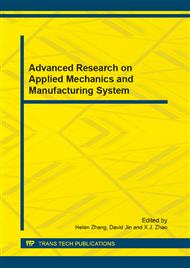[1]
Yang Lei, Huang Xiao_yan. The Design and Evaluation Model for Distribution Center Location Selection. Statistics and Strategy. 2008. 9.
Google Scholar
[2]
You De_sheng. The Location Selection of Warehouse [J]. China Logistics and Purchase. 2007. 12.
Google Scholar
[3]
LiMin, Zhou Yang, Peng Yuan_zhen. The Application of AHP in the Logistics Network Arrangement[J]. Fujian Computer. 2008. 7.
Google Scholar
[4]
ZhouMei_hua. Analysis of Intensive Distribution Center Location Selection[J]. Jounal of China Mining University. 2009, 29(6).
Google Scholar
[5]
LuXiao_chun, ZhanHe_sheng. Research on Center Methodology of Distribution Center Location Selection [J]. Journal of Beijing Transportation University. 2000, 24(6).
Google Scholar
[6]
Feng Rui_fang, Feng Chao. the Research on Distribution Center Location Selection [J]. Scientific Technology and Construction. 2008, 8(12).
Google Scholar
[7]
Lin Ya_hui, Zhong Xiao_yan, Zhong Cong_er, Qiu Rong_zu. Genetic Algorithm Based Timber Logistics Center Location Selection [J]. Operation and Management. 2007, 16(6).
Google Scholar
[8]
Maria Albareda-Sambola, Elena Fernandez, Gilbert Laporte. The Capacity and Distance Constrained Plant Location Problem. Copmuters & Operations Research. 2009. 36.
DOI: 10.1016/j.cor.2007.10.017
Google Scholar
[9]
Shams-ur Rahman, David K. Smith. Use of Location-allocation Models in Health Service Development Planning in Developing Nations[J]. European Journal of Operational Research, 2000, 123(3): 437-452.
DOI: 10.1016/s0377-2217(99)00289-1
Google Scholar
[10]
Kostas G. Zografos. Analytical Framework for Minimizing Freeway-Incident Response Time[J]. Journal of Transportation Engineering. 1993, 119(4): 535-549.
DOI: 10.1061/(asce)0733-947x(1993)119:4(535)
Google Scholar
[11]
Geoffrey N. Berlin, Jon C. Liebman. Mathematical Analysis of Emergency Ambulance Location[J]. Socio-Economic Planning Sciences, 1974, 8(6): 323-328.
DOI: 10.1016/0038-0121(74)90036-6
Google Scholar
[12]
C. S. ReVelle, H. A. Eiselt. Location Analysis: A Synthesis and Survey[J]. European Journal of Operational Research. 2005, 165(1): 1-19.
DOI: 10.1016/j.ejor.2003.11.032
Google Scholar
[13]
Daskin MS. A Maximal Expected Set Covering Location Model: Formulation, Properties, and Heuristic Solution[J]. Transportation Science, 1983, 17: 48–69.
DOI: 10.1287/trsc.17.1.48
Google Scholar
[14]
Glover F. Future Paths for Integer Programming and Links to Artificial Intelligence [J]. Computer s and Operations Research, 1986, 13: 533-549.
DOI: 10.1016/0305-0548(86)90048-1
Google Scholar


